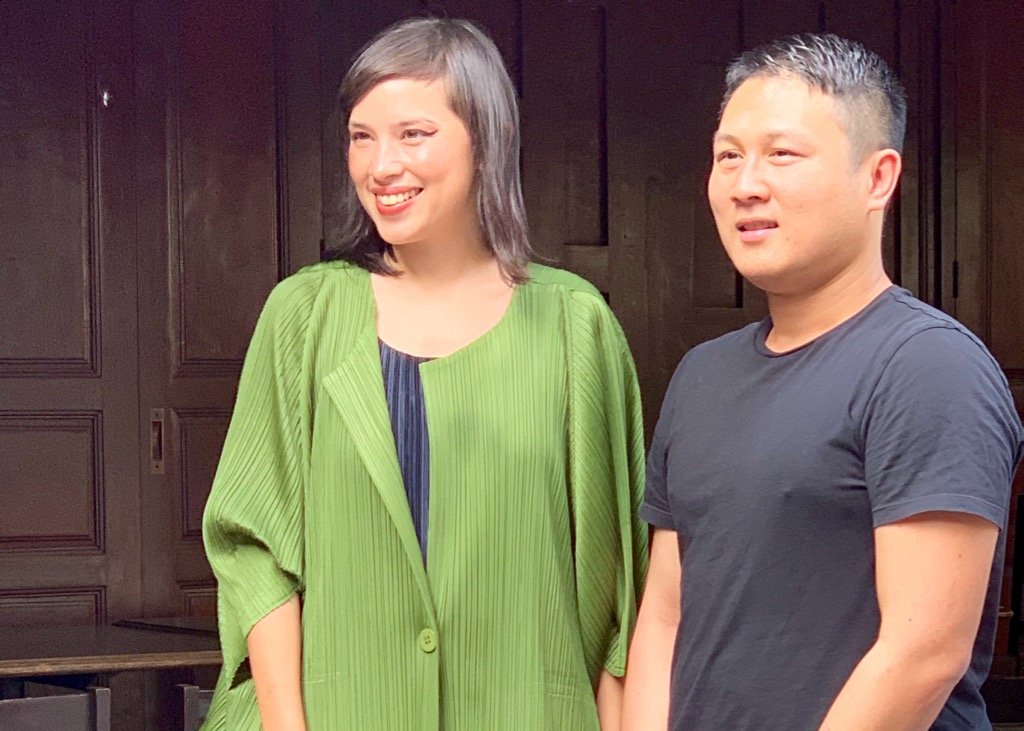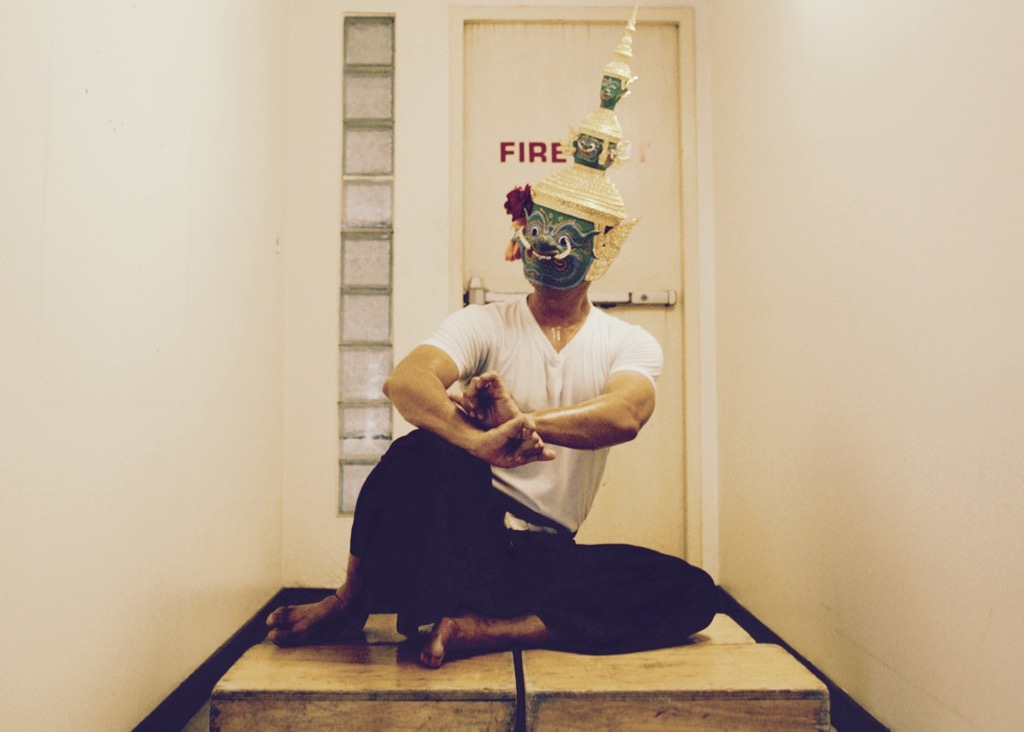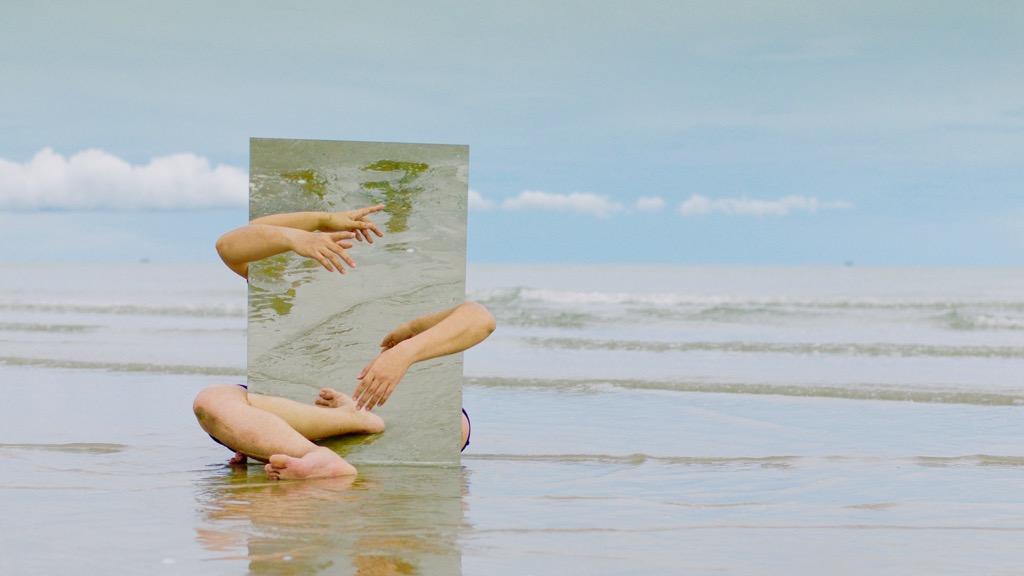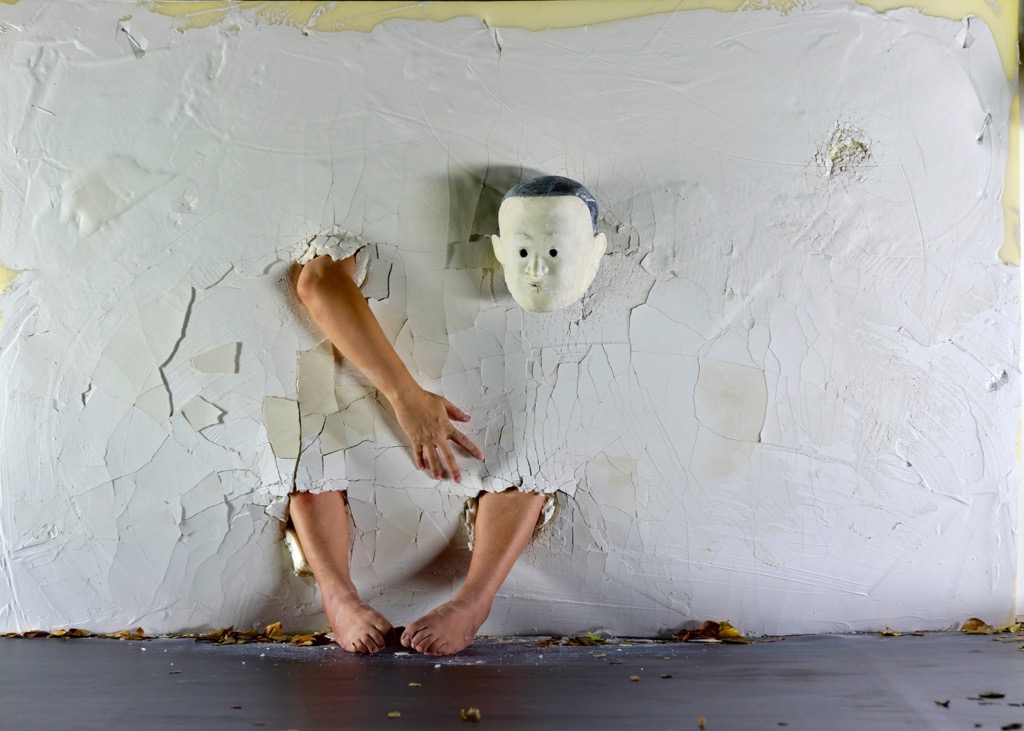Reimagining Khon
An Interview with Thanpuying Sirikitiya Jensen and Jitti Chompee on the “Khon: Human Body: Embodiment, Knowledge Management” Project and the performance of “Melancholy of Demon”
Khon is often viewed as an intricate Thai masked dance-drama. However, this year a modern historian and a contemporary choreographer combine their visions to reimagine and reinterpret the classical art form. Thought-provoking concepts and inspirations entwine and divinely dramatic results ensue.
Over centuries Khon has amalgamated various artistic traditions and practices, from beliefs to literature, music, singing narration, choreography, mask making, textiles and costumes etc. Its accumulated body of knowledge enables the creations in Thai theatrical art of great sophistication.
Thanpuying Sirikitiya Jensen or Khun Mai, a historian from the Fine Arts Department, recently commissioned Jitti Chompee, a choreographer and the founder of the 18 Monkeys Dance Theatre and the Unfolding Kafka Festival, to conduct research and create artistic content under the Silpakorn Knowledge Management (KM) Project of 2020. This led to Jitti’s new creations, “Khon: Human Body: Embodiment, Knowledge Management” and “Melancholy of Demon,” to delve into history, artistry, and beliefs intrinsic to Khon and to present this cultural knowledge to modern-day audiences in an accessible way.


Khun Mai says, “Before this project, I didn’t have any background in performing arts. I’m a ‘loog khrueng’ (mixed race) and grew up in the States. I’ve been back to get to know more about myself… I learn Thai history by talking to people every day. We talk about music, dance, food and varied facets of history which are differently documented and interpreted from the main one. Over time, art and everyone evolve. So history and culture have to have life. We need to keep the same spirit of information and manage history into a dialogue.
“I studied political history and foreign policy but I’m a pacifist. I like art as soft diplomacy. A few years ago my project ‘Wang Na Narumit‘ was exhibited. It brought life back to the National Museum, the former site of Wang Na (The Front Palace). But when I watched Khon Phraratchathan (Khon sponsored by the SUPPORT Foundation), it was hard for me to understand. So I wondered about it and wanted to find out more meanings. I wanted to connect with the art like when I watched Indian Raslila (Ras dance). The music, the sound, the smell—all these sensory experiences—connect people with the art. So art is transformative. On the education and communication levels, I want to keep pumping fire into Khon. So I think we have to adjust how we teach but with trust and respect. For me, knowledge management is a contemporary take on heritage preservation. I believe in not changing the art form but to play, to experiment and to connect with it.”
Khun Mai had the opportunity to watch Jitti’s “Piazzolla & 18 Monkeys” and initiated this new project. Jitti recalls, “I asked Khun Mai about her interests, viewpoints and topics for research and study. I introduced some ideas and, fortunately, we had similar opinions. I started to interview distinguished Khon masters and experts to discover interesting stories and anecdotes as the topics for short documentary films. These allow us to tell Khon’s history, customs and codes of conduct via contemporary conceptualisation and media.


“This originates a fruitful and mutual understanding between traditional Khon dance and contemporary art. Although it still has a long way to reach a harmonious point of synthesis, we need to keep this alive. It’s critical to ensure that the modern public can access the knowledge. As current generations grow farther away from ancient arts, we need to bridge the gap by reinvigorating their communicability and relevance. If the medium is engaging and easily digestible, they will certainly appreciate the information. I extract the essence of Khon by stripping down extraneous elements and narrowing the focus to probe deeper into key elements. This distillation can be effective in imparting fundamental knowledge to the audience.”
Khun Mai explains, “This is very challenging to me because it’s new. It’s not a new concept, but people think that contemporary art forms may be controversial. The controversy comes from fear, because if you play with it too much you will do it an injustice. We keep the history solid to the core and the memory preserved but information needs flexibility to flow. In respect of the essence of the art, I work with historical content via contemporary communication tools. Bringing this together is steady, tedious and emotionally painful but history is the important purpose. If we don’t understand it completely, people may fear that it’s going to lose its form, essence and spirit. But we change and toy with how we communicate because now we like things that happen quickly. So we need to keep it moving.
“I want the Fine Arts Department to experiment. As a contemporary choreographer, Jitti met teachers, narrators, dancers and historians such as Khru Mued, Khru Pakorn and Khru Charan at the National Theatre. They built relationships, developed trust and emotional connections and learned something. Then their stories inspire and influence new works. Being sensitive to this delicate art form, we interweave old and new ways. Jitti gave his creative direction. There are two separate parts of knowledge management: the multimedia and the performance. We create information platforms such as movies, books and performances and distribute them as widely as possible. Curators, teachers and tour guides who tell stories and interpret information to connect with their audience are also in knowledge management. Our goal is to facilitate and make it accessible.
“The Khon anecdotes are about art forms bound in belief systems. Thai culture and beliefs came from India. For example, we believe that a human body has different levels, as in body architecture, and that the head is the highest point. Around Asia, Kathakali and other religious dances are transformative dances in a belief system. When Khon is performed, this temporary cosmology with surrounding gods is created. Performers assume the god’s roles and temporarily create a heaven on earth. They represent characters under Khon masks so the dancers are no longer themselves. On a spiritual level, this ties people to the art and history and transforms meanings in their everyday life. Another sample, Khru Jom, a Khon mask-maker, always wears white and observes the precepts when he creates a Phra Pirap (Bhairava, a powerful transcendental deity) mask. Or when the spire of a headdress is broken while performing, a teacher has to take it off from the performer’s head. The dancer cannot do that himself. The belief system goes deep in the heart or the spiritual level, beyond the physical level. These connections and feelings to the art are very powerful and valuable.”


Jitti says, “These anecdotes aren’t unheard of, but there’s such a great deal of information and knowledge. It takes years to collect and we can’t assemble all of it. It must be extracted and reduced to a bare minimum. For me, this is the magic of Khon. For instance, when using masks at shifting angular degrees, it helps convey a spectrum of emotions. Each mask also has a thread inside the mouth. Khon performers would hold these strings in their mouths to keep the masks from swaying and to keep their faces close to the masks, but there are more benefits. Without doing it, it may feel strange or unaccustomed to. These threads are the same sort that are sewn to hold the costumes close to the body and they may remind them of the deities in the Wai Khru ceremony (the rituals of venerations to teachers). These are the ties that bind.”
In “Melancholy of Demon,” Jitti explores an embodiment of the demon Tossakan’s narrative possibilities in a minimalistic approach through three concepts: body architecture, moving sculpture and dance scenography. When stripped bare of its embellishments, Khon is merely left with its fundamental function of narration. He investigates the mechanics of movement, which is devised around storytelling and character expression. He says, “I had to work really hard with Khon performers and observe how they think, believe and use their skills. With outsider’s eyes, we bring our knowledge and thinking to help them develop their talents or communicate more. I dissected or deconstructed Khon into some subjects that may have been ignored or failed to see. The more I work, the more I find interesting anecdotes that we can discuss and exchange.
“I discovered that Khon embodies the body architecture concept. Thai traditional architecture influenced the choreography, body postures and costume structures in shape and proportion. I’m also interested in how physical musicality, narration and dialogue effect dance movements. Khon is about body language such as hand gestures in a sign language. For the moving sculpture concept, in lieu of frontal orientation, we manipulate bodies in sculptural styles and alter the expressivity by bringing the posterior to the fore. The compositions of movements can be appreciated from diverse perspectives. In the dance scenography and landscape concept, instead of the traditional horizontal plane, we will perform in a bare vertical canvas like mural paintings. Through the body’s lines and contours, the sole interaction of bodies can conjure a sense of poetry inherent in traditional Thai visual arts. The challenge is to find the connections between traditional beliefs and contemporariness.”


Khun Mai notes, “These three concepts combine both classical and contemporary balance. They communicate with the core of Khon and the same storyline. We chose to distil it and make it contemporary. For instance, without having multiple characters and a full orchestra on the stage, it’s reduced to one performer and one musical instrument in just one scene, like freezing it in time with distillation. So people can concentrate on the information, which is more impactful. We focus on Tossakan’s many layers and more textured character. We take his different elements apart. He can be charming and wear flowers on his mask when professing his love to Sita. There are also moments without music to show emotional depth. We want to test how people view, perceive and interpret the art. It may be quite jarring for some. Traditionalists may understand this completely or maybe not. This intersects historical and contemporary methods. I want to teach the essence of the art. On a deeper level, it may touch people in the way that reminds them of something. The goal is to create melancholy, a word that may create misconception. It’s about memory, atmosphere or colour tones that are missing, but quite unsure why. It’s the sentimentality, the missing context of the situation. It may be uncomfortable and not easy to explain. We mix it up and want people to see it, feel it, and connect with it. Then learn more, understand, transmit it in different ways, and take the next step.”
Jitti adds, “I use other kinds of art form to point out the essence of Khon, by inciting and not informing the audience. The key is in stripping down and refining, not reconstructing the dance. However, I use my artistry to reflect on the beauty of Khon. The new interpretation isn’t controversial but I can’t expect what the reactions will be. Traditionalists may need some time to digest and feel comfortable with it. Vice versa, it takes a lot of time to understand them too.”
Khun Mai concludes, “When doing something differently, it doesn’t come naturally. For example, the narrator is the person who controls the movements but Anucha Sumaman or Toeng dances and narrates at the same time. He has to direct himself and he struggles with it. It may be uncomfortable and unnatural. This tests the dancer’s perception of the situation. So how he perceives and communicates brings changes to the art form. Once the performer lets it go and understands, he will feel why it becomes like this and move forward with that.
“This project goes on for another year. I have a modest and minimal goal. We want people to be touched or struck by it and need to find out more. We challenge them to talk and open their minds. I want to develop a form of trust to have them interact with things. Actually, I’m shy and introverted but I ended up talking to people all the time. I didn’t realise that I would be interested in education—creative education—by teaching people how to interact with history, how to trust, not to destroy but to work with it and keep it alive in the correct way. Education is something I want to do. We learn something new all the time. In the future we will bring and give access in multi-sensory platforms to create and think. There’s a lot of work to test and change how we learn and process information that all art forms and history are connected. As a historian, it’s my sense of duty to keep history alive and distribute it in multiple ways, not just in books, for people.”
DETAILS
“Khon: Human Body: Embodiment, Knowledge Management”
“Miscellany of Khon” Documentary Screenings at Lido Connect on Mar. 11 and 12
The Performance of “Melancholy of Demon” at Lido Connect from Mar. 18 to 22
Discussions and Demonstrations at Neilson Hays Library on Mar. 27
www.18monkeysdancetheatre.com
Comments (3)
Dear friend. I truly just like your posting and your current web page all in all! That write-up is really plainly composed and without difficulty understandable. Your WordPress style is awesome as well! Would be awesome to discover exactly where My partner and i are able obtain this. Please hold up the very good work. We all need much more this kind of website owners just like you on the web and much less spammers. Wonderful man!
Pretty nice post. I just stumbled upon your weblog and wished to say that I have
truly enjoyed surfing around your blog posts. In any case I’ll be subscribing to your feed and I hope you write again soon!







www.Links.M106.COM
April 14, 2021Ive been meaning to read this and just never got a chance. Its an issue that Im very interested in, I just started reading and Im glad I did. Youre a excellent blogger, 1 of the very best that Ive seen. This weblog unquestionably has some facts on topic that I just wasnt aware of. Thanks for bringing this things to light.